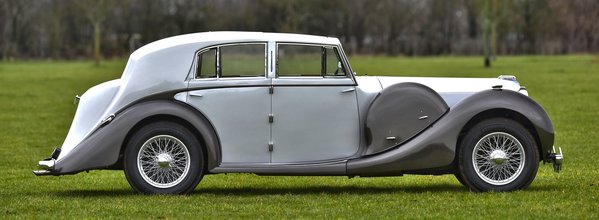Razor-Edge Lagonda V12s by Freestone & Webb
In that post I commented that Feeley's frontal design, the basis for both factory and custom bodies, was more rounded than, say, the angularity of Rolls-Royces. Which made me wonder if there were examples of Logonda V12s with angular bodies and how such bodies might relate to the rounded frontal design. It happens that the Freestone & Webb coachbuilding firm (brief Wikipedia entry here) built some "razor-edge" bodies (F&W initiated that style) on V12 Lagondas. Some these are shown below.
First, three images of a for-sale 1938 Lagonda V12 Short Chassis Saloon by Freestone & Webb. From the side, the contrasting curved and sharply-defined elements work well together.
Perhaps camera lens distortion affects this image, but the curved frontal elements appear cramped while the flat windshield makes the after part of the car seem too wide -- a contrast that doesn't seem to work well here.
This rear quarter view suggests the Razor-Edge part of the body is too delicate, given the robustly rounded front fender and spare tire cover.
This is a 1939 version in a "for sale" photo. The spare tire is missing, but that serves to lighten the front, making the curved and angular elements work better together.
The following three images are of a 1939 Lagonda V12 Sport Saloon with a Razor-Edge body by Freestone & Webb. I don't know the source of this photo. This camera angle and lens combination lessens the contrasts noted for the second image from the top.
That car was later up for auction by Bonhams, the source of this and the following photo. Again, the design holds together fairly well, but not perfectly.
This rear quarter view angle diminishes the effect of the front fender and spare tire cover combination.
I am forced to conclude from these photos (and not by viewing one of these cars in person) that Feeley's frontal identity features and Razor-Edge styling do not work very well together.









Comments
Post a Comment